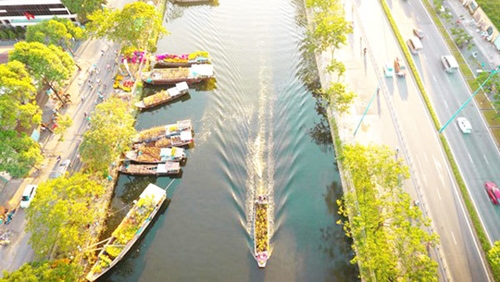The seminar, which discussed solutions for the development of public cultural spaces, attracted architectural and cultural experts as well as local leaders. It was organized by the municipal Party Committee's Propaganda Department, the Council for Theory, Literature and Arts Criticism and the Association of Architects.
Public cultural spaces are common places for community activities that all residents have the right to freely access and use such as squares, parks, pedestrian streets, surface water, spaces along the riverbank, and sidewalks.
They play an important role in strengthening social cohesion and improving the quality of life and physical and spiritual health of residents.
    |
 |
|
The river-based life of people in HCM City’s District 8. |
“The public space shows the city’s cultural identity and civilization,” general secretary of the city’s Association of Historical Sciences Nguyen Thi Ha said.
The city government should develop solutions on public space development to bring the most practical benefits to the community in a humane way, she said.
The city has been developed around rivers and canals, so its typical identity is a river-based culture.
Building public cultural spaces should promote the preservation of traditional intangible cultural heritage practices. The design for public cultural spaces should combine tradition and modernity, experts said.
Existing water bodies such as Sai Gon River or Thi Nghe Canal have been an integral part of the city’s development, making them ideal spaces to promote cultural public activities, architect Pham Phu Cuong said.
Nguyen Tan Van, former chairman of the city’s Association of Architects, said developing public spaces along rivers and canals would create a unique identity for the city.
Sharing the same idea, architect Nguyen Anh Tuan of the city's Department of Planning and Architecture, said that the landscapes along rivers and canals have the potential to become the backbone of urban cultural activities.
“The city should create public spaces associated with trade, entertainment and cultural activities on rivers and canals.”
More efforts and solutions are also needed to prevent pollution and improve the landscape along rivers and canals, he said.
Dr. Le Hong Phuoc from the HCM City University of Social Sciences and Humanities said the city should create a public space for don ca tai tu (Southern folk music) which has been recognized by UNESCO as an intangible cultural heritage.
Don ca tai tu performances could be organized at existing public spaces in the city such as Book Street on Nguyen Van Binh street in District 1.
The city should also set up a street to serve as a place for performing traditional arts, such as Huyen Tran Cong Chua street in District 1, he said.
Urban planning calls for 7sq.m of public space per capita but the current public space in the city is just 1.06sq.m per person.
Most existing public spaces are located in inner districts, while there are no or only a few public spaces in outlying districts.
More trees and water surface, and lights for existing public parks are needed, experts said.
The city should also learn from other countries’ experiences in building public space and consult leading architects.
Hậu said clearing illegal encroachment on pavements and roads in the city is needed. However, the city should research street planning to manage street vendors on pavements and roads, instead of clearing all of them because “street trading is a typical feature that attracts tourists".
Phan Nguyen Nhu Khue, head of the municipal Party Committee's Propaganda Department, said the city was considering building public spaces for cultural activities on Nguyen Thuong Hien street and an area around Ho Con Rua (Turtle Lake) in District 3.
At Ho Con Rua, it plans to organize don ca tai tu performances every Saturday night, art performances and entertainment programs for children every Sunday night, and musical fountain, water puppetry shows and exhibitions on other days.
The city will also develop an annual lantern festival in District 8.
Proposed solutions, ideas and suggestions at the seminar will be recorded to study in depth. These will help the city prepare a clear roadmap for building public spaces, he added.
Source: VNA